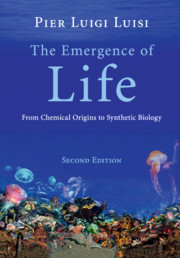Book contents
- Frontmatter
- Contents
- Acknowledgments
- Introduction
- Part I Approaches to the origin of life
- Part II What is life? The bio-logics of cellular life
- Part III Order and organization in biological systems
- Part IV The world of vesicles
- Part V Towards the synthetic biology of minimal cells
- 14 A panoramic view of synthetic biology
- 15 The minimal cell
- As a way of conclusion
- Appendix The open questions about the origin of life
- References
- Names index
- Subject index
14 - A panoramic view of synthetic biology
from Part V - Towards the synthetic biology of minimal cells
Published online by Cambridge University Press: 05 September 2016
- Frontmatter
- Contents
- Acknowledgments
- Introduction
- Part I Approaches to the origin of life
- Part II What is life? The bio-logics of cellular life
- Part III Order and organization in biological systems
- Part IV The world of vesicles
- Part V Towards the synthetic biology of minimal cells
- 14 A panoramic view of synthetic biology
- 15 The minimal cell
- As a way of conclusion
- Appendix The open questions about the origin of life
- References
- Names index
- Subject index
Summary
Introduction
As we have already mentioned, this last part of the book is devoted to the question of the minimal cell, namely, whether and to what extent by using the laboratory tools of synthetic biology (SB) we will be able to approach the construction of a living cell. Let us begin then with an illustration of SB at large, to focus later on the particular question of the minimal cell.
The brochure of the last synthetic biology congress in London (2014) opens up with a sentence stating that SB is predicted to be worth 10.8 billion dollars by 2016. Not bad for a relatively new branch of life sciences. Although, for some, SB is not really a novel branch of science, but actually a new dress for bioengineering within the broader field of biotechnology. It is indeed an offspring of the union between bioengineering and molecular biology, and in this vast field, it claimed from the very beginning a very ambitious program: that of creating new forms of life, alternative to the extant ones, which would permit us to tackle the energy problems of our world successfully, and produce new drugs cheaply. This ambitious statement becomes less high-sounding if one considers that, in reality, the new forms of life are restricted to bacterial life; and that SB aims at synthesizing simpler biological structures, not necessarily living, but still alternative to those found in nature.
One definition given in one important meeting in Zurich in 2007 (SB3) defines SB as a science intended to “engineer and study biological systems for achieving better understanding of life processes, generating and assembling functional modular components, or develop novel applications of processes.”
You see in this sentence two important points: one is the declared interest for the basic aspects of life science (not only the applied ones); and the notion of modularity, which, as we will see, is indeed very important for the development of bio-engineering SB.
Actually, the term synthetic biology was coined back in 1912 by the French chemist Leduc in 1912, but only recently has entered with force into the broad field of biotechnology and bioengineering, with a high number of yearly international meetings, several books and review articles, as well as new journals devoted to this area.
- Type
- Chapter
- Information
- The Emergence of LifeFrom Chemical Origins to Synthetic Biology, pp. 335 - 368Publisher: Cambridge University PressPrint publication year: 2016



